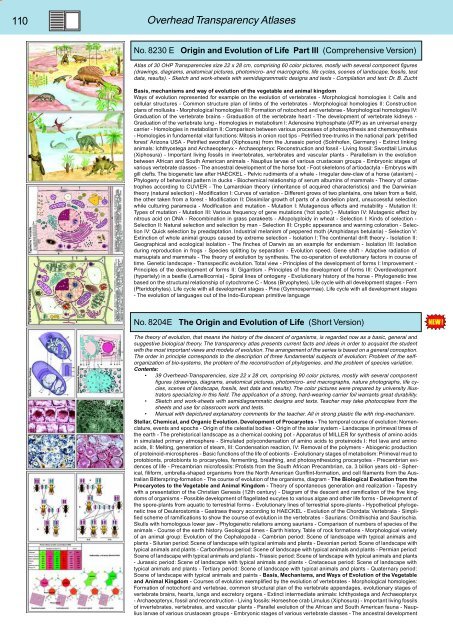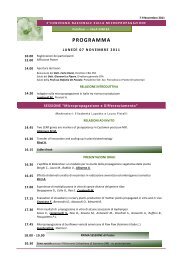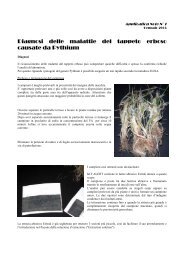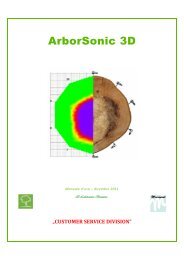BIOLOGY - microscopia.info
BIOLOGY - microscopia.info
BIOLOGY - microscopia.info
Create successful ePaper yourself
Turn your PDF publications into a flip-book with our unique Google optimized e-Paper software.
110<br />
Overhead Transparency Atlases<br />
No. 8230 E Origin and Evolution of Life Part III (Comprehensive Version)<br />
Atlas of 30 OHP Transparencies size 22 x 28 cm, comprising 60 color pictures, mostly with several component figures<br />
(drawings, diagrams, anatomical pictures, photomicro- and macrographs, life cycles, scenes of landscape, fossils, test<br />
data, results). - Sketch and work-sheets with semidiagrammatic designs and texts - Compilation and text: Dr. B. Zucht<br />
Basis, mechanisms and way of evolution of the vegetable and animal kingdom<br />
Ways of evolution represented for example on the evolution of vertebrates - Morphological homologies I: Cells and<br />
cellular structures - Common structure plan of limbs of the vertebrates - Morphological homologies II: Construction<br />
plans of mollusks - Morphological homologies III: Formation of notochord and vertebrae - Morphological homologies IV:<br />
Graduation of the vertebrate brains - Graduation of the vertebrate heart - The development of vertebrate kidneys -<br />
Graduation of the vertebrate lung - Homologies in metabolism I: Adenosine triphosphate (ATP) as an universal energy<br />
carrier - Homologies in metabolism II: Comparison between various processes of photosynthesis and chemosynthesis<br />
- Homologies in fundamental vital functions: Mitosis in onion root tips - Petrified tree-trunks in the national park ‘petrified<br />
forest’ Arizona USA - Petrified swordtail (Xiphosura) from the Jurassic period (Solnhofen, Germany) - Extinct linking<br />
animals: Ichthyostega and Archaeopteryx - Archaeopteryx: Reconstruction and fossil - Living fossil: Swordtail Limulus<br />
(Xiphosura) - Important living fossils in invertebrates, vertebrates and vascular plants - Parallelism in the evolution<br />
between African and South American animals - Nauplius larvae of various crustacean groups - Embryonic stages of<br />
various vertebrate classes - The ancestral development of the horse foot - Foot skeletons of artiodactyla - Embryos with<br />
gill clefts. The biogenetic law after HAECKEL - Pelvic rudiments of a whale - Irregular dew-claw of a horse (atavism) -<br />
Phylogeny of behavioral pattern in ducks - Biochemical relationship of serum albumins of mammals - Theory of catastrophes<br />
according to CUVIER - The Lamarckian theory (inheritance of acquired characteristics) and the Darwinian<br />
theory (natural selection) - Modification I: Curves of variation - Different grows of two plantains, one taken from a field,<br />
the other taken from a forest - Modification II: Dissimilar growth of parts of a dandelion plant, unsuccessful selection<br />
while culturing paramecia - Modification and mutation - Mutation I: Mutagenous effects and mutability - Mutation II:<br />
Types of mutation - Mutation III: Various frequency of gene mutations (‘hot spots’) - Mutation IV: Mutagenic effect by<br />
nitrous acid on DNA - Recombination in grass parakeets - Allopolyploidy in wheat - Selection I: Kinds of selection -<br />
Selection II: Natural selection and selection by man - Selection III: Cryptic appearance and warning coloration - Selection<br />
IV: Quick selection by preadaptation. Industrial melanism of peppered moth (Amphidasys betularia) - Selection V:<br />
Extinction of whole animal groups caused by extreme selection - Isolation I: The continental drift theory - Isolation II:<br />
Geographical and ecological isolation - The finches of Darwin as an example for endemism - Isolation III: Isolation<br />
during reproduction in frogs - Species splitting by separation - Evolution speed. Gene shift - Adaptive radiation of<br />
marsupials and mammals - The theory of evolution by synthesis. The co-operation of evolutionary factors in course of<br />
time. Genetic landscape - Transspecific evolution. Total view - Principles of the development of forms I: Improvement -<br />
Principles of the development of forms II: Gigantism - Principles of the development of forms III: Overdevelopment<br />
(hypertely) in a beetle (Lamellicornia) - Spiral lines of ontogeny - Evolutionary history of the horse - Phylogenetic tree<br />
based on the structural relationship of cytochrome C - Moss (Bryophytes). Life cycle with all development stages - Fern<br />
(Pteridophytes). Life cycle with all development stages - Pine (Gymnospermae). Life cycle with all development stages<br />
- The evolution of languages out of the Indo-European primitive language<br />
No. 8204E The Origin and Evolution of Life (Short Version)<br />
The theory of evolution, that means the history of the descent of organisms, is regarded now as a basic, general and<br />
suggestive biological theory. The transparency atlas presents current facts and ideas in order to acquaint the student<br />
with the most important views and models of evolution. The arrangement of the series is based on a general conception.<br />
The order in principle corresponds to the description of three fundamental subjects of evolution: Problem of the selforganization<br />
of bio-systems, the problem of the reconstruction of phylogenies, and the problem of species variation.<br />
Contents:<br />
• 39 Overhead-Transparencies, size 22 x 28 cm, comprising 90 color pictures, mostly with several component<br />
figures (drawings, diagrams, anatomical pictures, photomicro- and macrographs, nature photographs, life cycles,<br />
scenes of landscape, fossils, test data and results). The color pictures were prepared by university illustrators<br />
specializing in this field. The application of a strong, hard-wearing carrier foil warrants great durability.<br />
• Sketch and work-sheets with semidiagrammatic designs and texts. Teacher may take photocopies from the<br />
sheets and use for classroom work and tests.<br />
• Manual with depictured explanatory comments for the teacher. All in strong plastic file with ring-mechanism.<br />
Stellar, Chemical, and Organic Evolution. Development of Procaryotes - The temporal course of evolution: Nomenclature,<br />
events and epochs - Origin of the celestial bodies - Origin of the solar system - Landscape in primeval times of<br />
the earth - The prehistorical landscape as a chemical cooking pot - Apparatus of MILLER for synthesis of amino acids<br />
in simulated primary atmosphere - Simulated polycondensation of amino acids to proteinoids I: Hot lava and amino<br />
acids, II: Melting, generation of steam, III: Condensation reaction, IV: Removal of the polymers - Abiogenic production<br />
of proteinoid-microspheres - Basic functions of the life of eobionts - Evolutionary stages of metabolism: Primeval mud to<br />
protobionts, protobionts to procaryotes, fermenting, breathing, and photosynthesizing procaryotes - Precambrian evidences<br />
of life - Precambrian microfossils: Protists from the South African Precambrian, ca. 3 billion years old - Spherical,<br />
filiform, umbrella-shaped organisms from the North American Gunflint-formation, and cell filaments from the Australian<br />
Bitterspring-formation - The course of evolution of the organisms, diagram - The Biological Evolution from the<br />
Procaryotes to the Vegetable and Animal Kingdom - Theory of spontaneous generation and realization - Tapestry<br />
with a presentation of the Christian Genesis (12th century) - Diagram of the descent and ramification of the five kingdoms<br />
of organisms - Possible development of flagellated eucytes to various algae and other life forms - Development of<br />
the spore-plants from aquatic to terrestrial forms - Evolutionary lines of terrestrial spore-plants - Hypothetical phylogenetic<br />
tree of Deuterostomia - Gastraea theory according to HAECKEL - Evolution of the Chordata: Vertebrata - Simplified<br />
scheme of ramifications to show the course of evolution in the vertebrates - Saurians: Ornithischia and Saurischia.<br />
Skulls with homologous lower jaw - Phylogenetic relations among saurians - Comparison of numbers of species of the<br />
animals - Course of the earth history. Geological times - Earth history. Table of rock formations - Morphological variety<br />
of an animal group: Evolution of the Cephalopoda - Cambrian period: Scene of landscape with typical animals and<br />
plants - Silurian period: Scene of landscape with typical animals and plants - Devonian period: Scene of landscape with<br />
typical animals and plants - Carboniferous period: Scene of landscape with typical animals and plants - Permian period:<br />
Scene of landscape with typical animals and plants - Triassic period: Scene of landscape with typical animals and plants<br />
- Jurassic period: Scene of landscape with typical animals and plants - Cretaceous period: Scene of landscape with<br />
typical animals and plants - Tertiary period: Scene of landscape with typical animals and plants - Quaternary period:<br />
Scene of landscape with typical animals and paints - Basis, Mechanisms, and Ways of Evolution of the Vegetable<br />
and Animal Kingdom - Courses of evolution exemplified by the evolution of vertebrates - Morphological homologies:<br />
Formation of notochord and vertebrae, common structural plan of the vertebrate appendages, evolutionary stages of<br />
vertebrate brains, hearts, lungs and excretory organs - Extinct intermediate animals: Ichthyostega and Archaeopteryx<br />
- Archaeopteryx, fossil and reconstruction - Living fossils: Horseshoe crab Limulus (Xiphosura) - Important living fossils<br />
of invertebrates, vertebrates, and vascular plants - Parallel evolution of the African and South American fauna - Nauplius<br />
larvae of various crustacean groups - Embryonic stages of various vertebrate classes - The ancestral development







